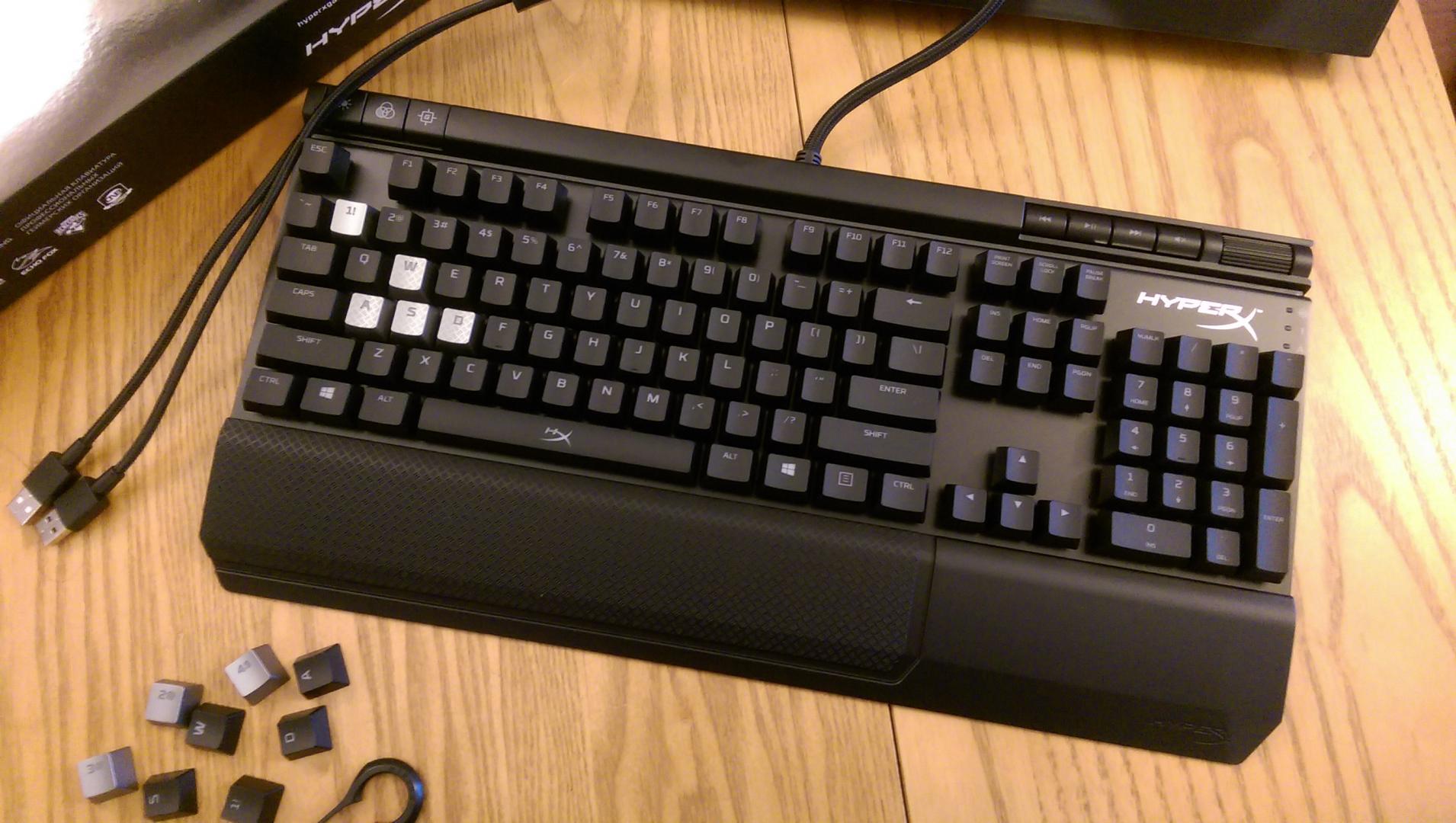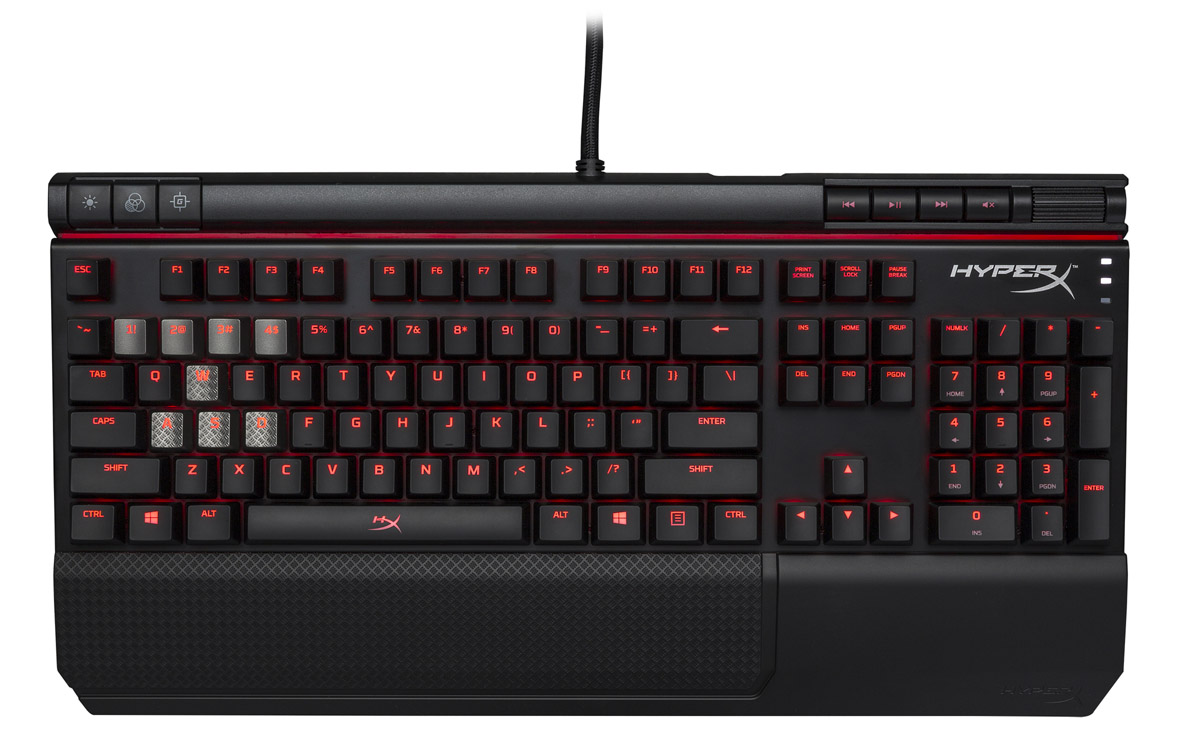

After an impressive debut into the mechanical keyboard market, HyperX has decided to expand their offerings for this particular peripheral. The HyperX Alloy Elite takes the rock-solid design of the Alloy, and adds onto and improves upon a few features.
You may recall that I was extremely impressed with the HyperX Alloy when I reviewed it back in October 2016. As someone who never cared to get in on the mechanical keyboard game, the Alloy converted me, winning me over with its compact design and no-nonsense features. Given that background, I was fairly certain I would also like the Alloy Elite.

Let’s start with what’s very similar or the same between the Alloy Elite and last fall’s Alloy. The main part of the keyboard is much the same, complete with a sturdy and compact solid-steel frame that still hosts a USB port along the top of the keyboard (a feature I would have sorely missed had they removed it). The power cord is a fully detachable woven cord that requires two USB ports to power, just like the Alloy. Both keyboards are fully plug-and-play with absolutely no software (a HyperX standard). The Alloy Elite features the same red LED backlighting as the Alloy, with the same backlight modes (Solid, Breathing, Trigger, Explosion, Wave, and Custom), though the way you toggle between them is slightly different (see below). They keycaps are all fully removeable and the Alloy Elite also comes with specially colored W, A, S, D and numbers 1-4 keycaps, though this time they’re platinum-colored instead of red. The W, A, S, and D keys are still textured and the 1-4 keys are still slightly raised. Both Alloy and Alloy Elite come with Cherry MX switches, with Red, Blue, and Brown switch options (my Alloy came with Cherry Blues and my Alloy Elite came with Cherry Reds).
The most noticeable differences are along the very top and bottom of the keyboard, which are extended compared to the Alloy. Along the bottom is a detachable wrist rest, which I was actually quite excited about since I’ve required wrist rests and wrist braces for years when gaming; however, it ended up being nothing exceedingly special. It’s fine and it does the job, but it doesn’t have any special padding. It’s made out of hefty plastic with soft-touch coating that makes it smooth to touch, and for my own personal preferences it’s slightly low, though I’m fairly certainly I like to elevate my wrists much higher than the average gamer.

Along the top of the board is a media panel (on the right) and keyboard feature panel (on the left). The media panel allows you to pause/play, skip between tracks, and mute the audio of a media app you’re watching or listening to. You can easily do so when you’re in another program or playing a game, which is convenient. There’s also a volume control wheel, which gets major style points for actually being a huge metal cylinder that’s embedded inside the top of the panel. Its unconventional design is functional, too, as I have yet to accidentally bump it (something that can often occur with standard plastic wheels along the sides of panels) and it’s easy to quickly locate and spin up or down without looking down.
The keyboard feature panel has dedicated buttons for LED brightness, LED mode (which cycles between the six aforementioned backlighting modes), and Game Mode. These were all available on the Alloy, but now we get dedicated buttons for them rather than using key combinations. Though convenient, I won’t be making too much use of the dedicated LED brightness and LED mode buttons, since I generally just find the setting I like and stick with it. The dedicated Game Mode button, though, I absolutely approve it. Game Mode is simply a toggle to disable the Windows button so you don’t accidentally mash it in the middle of the game and ruin everything. It’s insanely smart and had I been in possession of it before the Alloy, I would have saved myself a lot of tears. There were two issues I had with it on the original Alloy, however: the keyboard couldn’t save the setting when it was powered off and I’d often have to use the dual key command twice (SHIFT F12) to turn Game Mode on correctly. The Alloy Elite resolves both issues and I couldn’t be happier about that.
When directly comparing the two keyboards, the Alloy has the edge for portability since the Alloy Elite doesn’t come with a travel bag and it’s a bit bigger, even without the wrist rest. If portability isn’t a concern, however, then the Alloy Elite wins out for its slightly expanded and slightly improved features (media and keyboard feature panels, wrist rest, and my personal favorite: improved Game Mode functionality). If you have the Alloy, should you upgrade to the Elite? I’d say in most cases, probably not with the exception being if you really NEED a media control panel on your keyboard. The Alloy Elite is very similar to the Alloy, and they provide very similar experiences. If you don’t have either and wanted to buy one, I’d recommend going for the Alloy Elite. The announced retail price of the Alloy Elite is $110 (compare this with the current price of the Alloy at $100), and the slight improvements are worth this rather small price increase.
Abbreviated Specifications
Dimensions: Width 444.00mm Depth 226.80mm Height 36.30mm Weight (Keyboard and cable) 1467g Connection type USB 2.0 (2 USB connectors) OS compatibility Windows® 10, 8.1, 8, 7The bottom line here is the the Alloy Elite is an exceptional mechanical keyboard, which is only to be expected since it’s so similar to the phenomenal Alloy. The Alloy Elite is exceedingly responsive, well-constructed, and still reasonably compact, even with the wrist rest attached. Provided its pricing is comparable to the Alloy, I highly recommend it to PC gamers who want excellent performance, a durable structure, and minimalist features for a reasonable price.